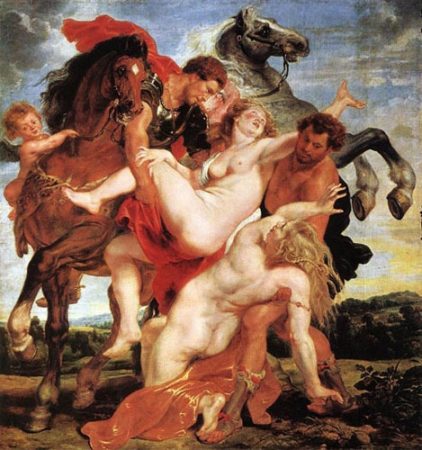Painted by Peter Paul Rubens around 1617, the painting The Abduction of the Daughters of Leucippus represents a scene from Greek mythology. It is now on display at the Alte Pinakothek in Munich.
A sensual register at the center of Greek mythology
In 1617, the artist painted an imposing picture that recounts a classic mythological story. The kidnapping of Phoebe and Hilary, the daughters of the king of Argos Leucippus, by the twins Castor and Pollux who are seduced by the beauty of the princesses. Acting on this episode, they engaged in a battle against the brothers and fiancés of the two young women, during which Castor was killed and Pollux asked their father Jupiter to grant them immortality.
The artist imposes here a style that is well known to him, namely a representation of bodies very sensual and quivering. The buttocks, the stomach, the breasts are represented by a way of painting very specific to the Baroque painter. Thus, Paul Rubens exploits here a mythological scene to declare a hymn to female beauty. No religious or political register here for an artist who was in his time an ambassador for the most powerful. His numerous diplomatic actions earned him a knighthood from King Philip IV of Spain, just like King Charles I of England.
An artistic composition that makes you travel
To return to the painting which is studied in many art schools and on which Jean Baptiste Gouraud spent a few hours as a student, Paul Rubens takes great pleasure in the possibility he has to represent naked bodies. In terms of colors, we find in this painting the particular pinks of the female bodies which turn to the reds of the fabrics with which the kidnappers are draped to end on the brown of the skin of the latter. The sparkles are also present since we find a golden hair that contrasts with the silver color of an armor on the same frame. Finally, there is no lack of light colors. The sky blue is mixed with a light yellow and a sky gray that announce the sunset.
The scene makes you dream and transports you to discover the course of the kidnapping. From the horses rearing up, struggling to fit into the already imposing frame, to the men bending over to catch the two struggling women, the scene is transcribed in motion to bring this beautiful world to life. A last actor intervenes in this drama on the left of the painting, in the form of a cherub intended to indicate to the spectators that only love is at the center of these actions.
Having become immortal, the two brothers marry the sisters and have children, and so we leave dazzled by the painter’s narrative, which has succeeded once again in transporting its spectators.
